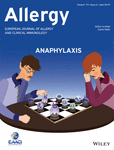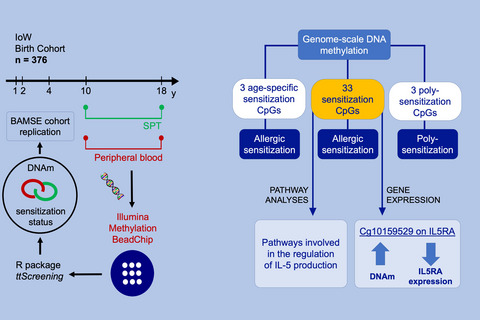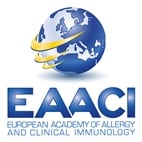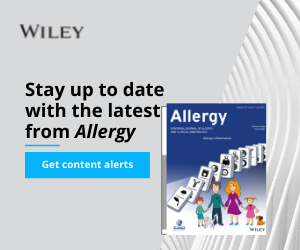Journal list menu
Export Citations
Download PDFs
ISSUE INFORMATION
Issue Information - Cover and Editorial Board
- Page: 1027
- First Published: 07 June 2019
IN THIS ISSUE
EDITORIAL
A perspective on the pediatric death from oral food challenge reported from the Allergy Vigilance Network
- Pages: 1035-1036
- First Published: 20 March 2019
POSITION PAPER
AllergoOncology: Microbiota in allergy and cancer—A European Academy for Allergy and Clinical Immunology position paper
- Pages: 1037-1051
- First Published: 12 January 2019
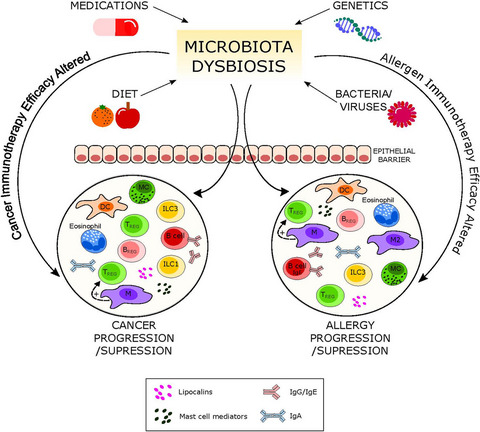
Increasing scientific evidence indicates the influence of microbiota on the immune response contributing to the prevention or progression of immune-related diseases such as allergy and cancer. A variety of factors have been identified influencing microbiota composition. This opens new avenues to beneficially modulate patients’ responses to cancer or allergy treatments.

A EAACI drug allergy interest group survey on how European allergy specialists deal with β-lactam allergy
- Pages: 1052-1062
- First Published: 14 January 2019
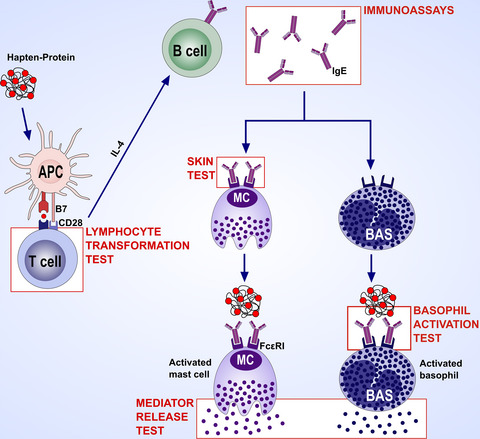
Allergy testing in immediate and nonimmediate reactors to betalactams. The combination of amoxicillin plus clavulanic acid and amoxicillin alone was the most commonly involved BL, although differences among countries concerning the most common penicillin involved exist. All centres performed an allergy workup in subjects with histories of hypersensitivity to BL although there were heterogeneity and deviations from DAIG recommendations concerning allergy tests. Data from this survey suggest the need to re-evaluate, update and standardize protocols on the management of patients with suspected BL allergy.

REVIEW ARTICLE
The global incidence and prevalence of anaphylaxis in children in the general population: A systematic review
- Pages: 1063-1080
- First Published: 28 January 2019
ORIGINAL ARTICLES
Basic and Translational Allergy Immunology
Gene therapy for C1 esterase inhibitor deficiency in a Murine Model of Hereditary angioedema
- Pages: 1081-1089
- First Published: 30 July 2018
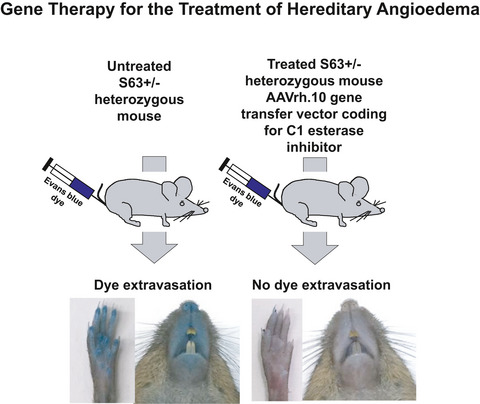
A novel murine model of hereditary angioedema (HAE) was created using CRSIPR/Cas9 technology, which reproduces the human HAE phenotype at both molecular and phenotypic levels. A single administration of a nonhuman primate serotype rh.10 adeno-associated virus coding for C1 esterase inhibitor (AAVrh.10hC1EI) results in sustained human C1EI levels above the predicted therapeutic levels and correction of the vascular leak in the skin, paws, and internal organs of HAE mice. If this strategy can be translated to humans, it would represent a paradigm shift for the treatment of patients with clinically significant hereditary angioedema.
House dust mite drives proinflammatory eicosanoid reprogramming and macrophage effector functions
- Pages: 1090-1101
- First Published: 16 December 2018
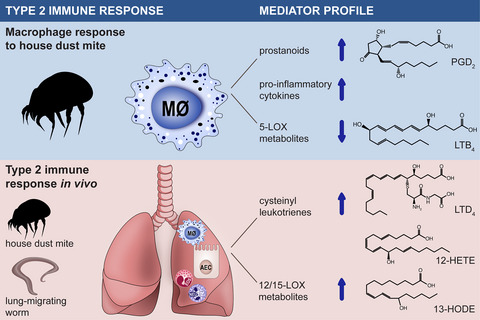
House dust mite triggers the production of cyclooxygenase metabolites (prostaglandin D2, prostaglandin E2 and thromboxane) as well as of proinflammatory cytokines in human macrophages. House dust mite-exposed macrophages produce low levels of 5-lipoxygenase metabolites (e.g. leukotriene B4) and suppress neutrophil recruitment.
High levels of cysteinyl leukotrienes and 12-/15-lipoxygenase metabolites are produced during the type 2 immune response to house dust mite or nematode parasites in the airways.
AEC: Airway epithelial cell; COX: Cyclooxygenase; cysLT: Cysteinyl leukotriene; HDM: House dust mite; HETE: Hydroxyeicosatetraenoic acid; HODE: Hydroxyoctadecadienoic acid; LOX: Lipoxygenase
Asthma and Lower Airway Disease
Contribution of airway eosinophils in airway wall remodeling in asthma: Role of MMP-10 and MET
- Pages: 1102-1112
- First Published: 22 January 2019
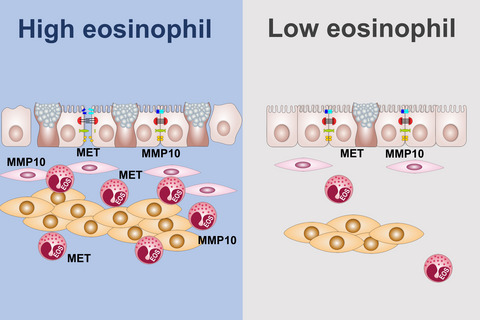
Analysis of differentially expressed genes in eosinophil-high biopsies of asthma yielded MMP10 and MET as potential drivers of airway wall remodeling. Important pathways include extracellular matrix organization, mast cell activation, C-C receptor binding, and regulation of leukocyte activation. Bronchial eosinophils are important drivers of airway wall remodeling in asthma. MMP10: Matrix metalloprotease 10 gene. MET: Hepatocyte growth factor receptor gene.
Rhinitis, Sinusitis, and Upper Airway Disease
Dysregulated fatty acid metabolism in nasal polyp-derived eosinophils from patients with chronic rhinosinusitis
- Pages: 1113-1124
- First Published: 22 January 2019
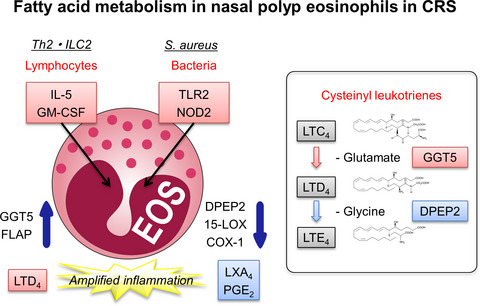
Eosinophils isolated from nasal polyps of patients with eosinophilic rhinosinusitis possess dysregulated fatty acid metabolism. Of the CysLT (cysteinyl leukotriene) biosynthetic pathway metabolites, LTD4 production is selectively enhanced with increased expression of GGT5 (gamma-glutamyl trasferase-5) and decreased expression of DPEP2 (dipeptidase-2). Type 2 cytokines (IL-5 and GM-CSF) and agonists of TLR2 and NOD2 induce similar changes of fatty acid metabolism.
COX: Cyclooxygenase; CRS: Chronic rhinosinusitis; DPEP2: Dipeptidase-2; GGT5: Gamma-glutamyl trasferase-5; GM-CSF: Granulocyte-macrophage colony-stimulating factor; ILC2: Type 2 innate lymphoid cells; LTC4: Leukotriene C4; LTD4: Leukotriene D4; LTE4: Leukotriene E4; LXA4: Lipoxin A4; NOD2: Nucleotide binding oligomerization domain containing 2; PGE2: Prostaglandin E2; Th2: Type 2 helper T cells; TLR2: Toll-like receptor 2
Safety and reproducibility of nasal allergen challenge
- Pages: 1125-1134
- First Published: 22 January 2019
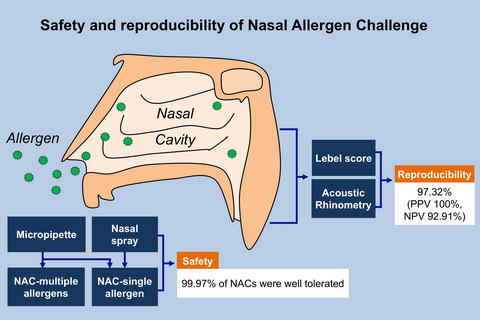
This study evaluates 11 499 Nasal Allergen Challenges (NAC) conducted in 6348 adult and paediatric rhinitis patients and in healthy controls. The NAC is a very safe technique in children and adults and it is highly reproducible when monitored by Lebel symptoms score and acoustic rhinometry. No difference in terms of NAC safety and reproducibility were detected between different allergen application methods or NAC protocols, distinct rhinitis phenotypes, or the presence or absence of asthmatic symptoms.
PPV: Positive predictive value; NPV: Negative predictive value.

Atopic Dermatitis, Urticaria and Skin Disease
Eicosanoid mediator profiles in different phenotypes of nonsteroidal anti-inflammatory drug-induced urticaria
- Pages: 1135-1144
- First Published: 22 January 2019
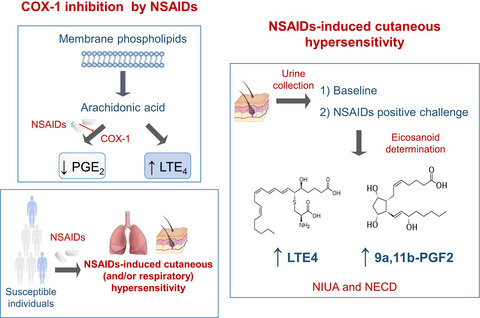
The inhibition of COX-1 by NSAIDs shunts the metabolism of arachidonic acid from PGE2 toward LTE4 synthesis. After NSAIDs intake, some individuals develop cutaneous and/or respiratory hypersensitivity reactions. Although NIUA and NECD showed distinct urinary eicosanoid excretion profile curves, ASA challenge results in an increase of LTE4 and 9a,11b-PGF2 in both.
COX-1: Cyclooxygenase 1; LTE4: Leukotriene E4; NECD: NSAIDs-exacerbated cutaneous disease; NIUA: NSAIDs-induced urticaria/angioedema; NSAIDs: Nonsteroidal anti-inflammatory drugs; PGE2: Prostaglandin E2; 9a,11b-PGF2: 9α,11β-prostaglandin F2
Drug Allergy, Insect Sting Allergy, and Anaphylaxis
The orphan nuclear receptor NR4A1 promotes FcεRI-stimulated mast cell activation and anaphylaxis by counteracting the inhibitory LKB1/AMPK axis
- Pages: 1145-1156
- First Published: 19 December 2018
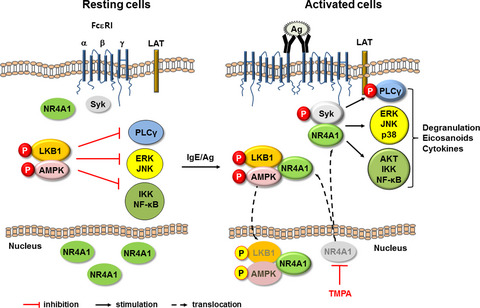
Nuclear receptor subfamily 4 group A member 1 augments mast cell activation by negatively regulating liver kinase B1/adenosine monophosphate-activated protein kinase and positively regulating spleen tyrosine kinase. Ethyl 2-[2,3,4-trimethoxy-6-(1-octanoyl)phenyl]acetate, a high-affinity nuclear receptor subfamily 4 group A member 1 antagonist, inhibits mast cell activation. Nuclear receptor subfamily 4 group A member 1 is a novel drug target for mast cell-dependent allergic diseases.
AMPK: AMP-activated protein kinase; LKB1: liver kinase B1; NR4A1: Nuclear receptor subfamily 4 group A member 1; Syk: spleen tyrosine kinase; TMPA: Ethyl 2-[2,3,4-trimethoxy-6-(1-octanoyl)phenyl]acetate
Paired acute-baseline serum tryptase levels in perioperative anaphylaxis: An observational study
- Pages: 1157-1165
- First Published: 21 February 2019
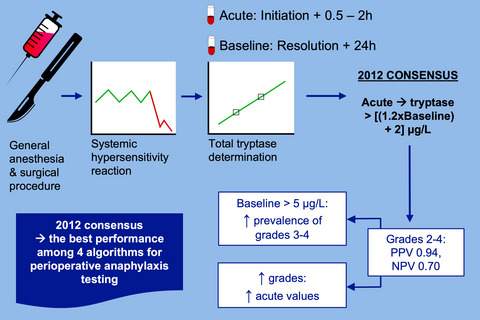
The 2012 consensus that acute tryptase should be greater than [(1.2 × baseline tryptase) + 2] μg/L performs best among four algorithms for tryptase interpretation during perioperative anaphylaxis. The 2012 consensus that acute tryptase should be greater than [(1.2 × baseline tryptase) + 2] μg/L performs best for reaction grades 2, 3 and 4. Higher anaphylaxis grades are associated with higher levels of acute tryptase and more prevalent if baseline tryptase levels are above 5 μg/L.
PPV: Positive predictive value; NPV: Negative predictive value
Epidemiology and Genetics
DNA methylation and allergic sensitizations: A genome-scale longitudinal study during adolescence
- Pages: 1166-1175
- First Published: 14 February 2019
LETTERS TO THE EDITOR
Rapid quantification of sputum eosinophil peroxidase on a lateral flow test strip
- Pages: 1176-1178
- First Published: 28 December 2018
Treatment satisfaction in atopic dermatitis relates to patient-reported severity: A cross-sectional study
- Pages: 1179-1181
- First Published: 28 December 2018
Expansion of FOXP3+ regulatory CD4 T cells upon exposure to hymenoptera venom during the beekeeping season
- Pages: 1182-1184
- First Published: 28 December 2018
Determinants of omalizumab drug survival in a long-term daily practice cohort of patients with chronic urticaria
- Pages: 1185-1187
- First Published: 28 December 2018
Analysis of the factors associated with diagnostic skin test positivity in immediate-type hypersensitivity reactions due to proton pump inhibitors
- Pages: 1187-1190
- First Published: 11 January 2019
IgE-specific immunoadsorption: New treatment option for severe refractory atopic dermatitis
- Pages: 1190-1193
- First Published: 12 January 2019
Food-related anaphylaxis fatalities: Analysis of the Allergy Vigilance Network® database
- Pages: 1193-1196
- First Published: 12 January 2019
Epinephrine dispensings, allergy hospitalizations and the elimination of co-payments in Sweden
- Pages: 1197-1200
- First Published: 29 January 2019
CORRESPONDENCE
Stability of neuromuscular blocking drugs used for skin testing
- Pages: 1201-1202
- First Published: 07 June 2019
NEWS AND VIEWS: LEGENDS OF ALLERGY AND IMMUNOLOGY
Legends of allergy and immunology: Henning Løwenstein
- Pages: 1203-1205
- First Published: 19 March 2019
NEWS AND VIEWS: RECENT PATENTS IN ALLERGY AND IMMUNOLOGY
Recent Patents in Allergy/Immunology: Use of arginase inhibitors in the treatment of asthma and allergic rhinitis
- Pages: 1206-1208
- First Published: 13 March 2019




